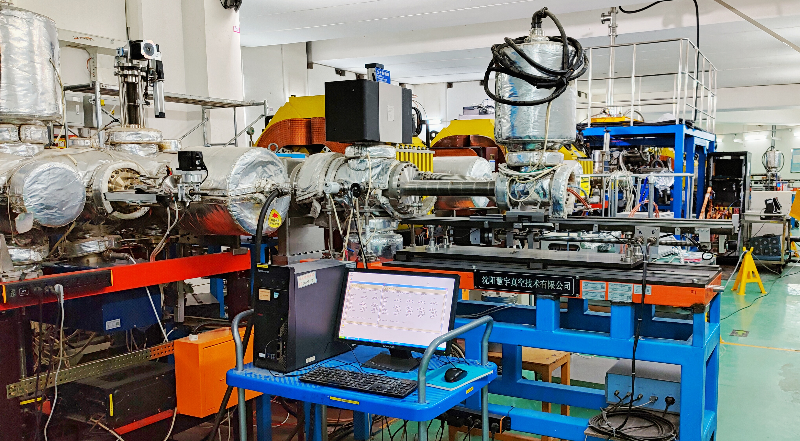At the Institute of Modern Physics (IMP) of the Chinese Academy of Sciences (CAS), scientists and their collaborators recently quantified the masses of numerous key nuclei with high accuracy by employing a sophisticated storage-ring mass spectrometry technique.

The detector system of nuclear mass spectrometer based on the Cooler Storage Ring (CSR) in Lanzhou. Image Credit: IMP
Using the new mass data, the researchers analyzed X-ray bursts on the surface of a neutron star, thus intensifying the knowledge of neutron star properties.
The study was reported in the Nature Physics journal.
Besides black holes, neutron stars are known to be the densest objects. Type-I X-ray bursts, among the brightest stellar objects often noted in the sky by space-based telescopes, are violent thermonuclear explosions happening on the surface of neutron stars.
As a result of the powerful gravity of the neutron star, hydrogen- and helium-rich matter from a companion star accumulates on the surface of a neutron star for hours or days before igniting thermonuclear burning. The explosion lasts for around 10 to 100 seconds, thereby causing a bright X-ray burst. Such frequent X-ray bursts provide a chance to study the properties of neutron stars.
The bursts have been powered by a nuclear reaction sequence called the quick proton capture nucleosynthesis process (rp-process), which includes hundreds of exotic neutron-deficient nuclides. Among them, the waiting-point nuclides, such as germanium-64, play a critical role.
Germanium-64, like a crossroad on the path of nuclear reaction processes, is an important congested section encountered when the nuclear reaction proceeds to the medium mass region. The masses of the relevant nuclei are decisive in setting the reaction path and thereby the X-ray flux produced.
Xu Zhou, Study First Author and Ph.D. Student, Institute of Modern Physics, Chinese Academy of Sciences
Hence, precision mass measurements of the nuclei next to germanium-64 are necessary for comprehending X-ray bursts and the properties of neutron stars. But as a result of the extremely low production yield, it has been highly difficult to quantify the masses of these short-lived nuclei. Consequently, few discoveries have been seen for many years across the world.
Following an effort for a decade, the scientists from the Storage Ring Nuclear Physics Group at IMP have come up with a new ultrasensitive mass spectrometry method at the Cooler Storage Ring (CSR) of the Heavy Ion Research Facility in Lanzhou (HIRFL).
This method, referred to as Bρ-defined Isochronous Mass Spectrometry (Bρ-IMS), is quick and effective, thus specifically idle for quantifying short-lived nuclei with extremely low production yields.
Our experiment is capable of precisely determining the mass of a single nuclide within a millisecond after its production, and it is essentially background free in the measured spectrum.
Meng Wang, Professor, Institute of Modern Physics, Chinese Academy of Sciences
The scientists accurately quantified the masses of arsenic-64, selenium-66, arsenic-65, selenium-67, and germanium-63. The masses of arsenic-64 and selenium-66 were experimentally quantified initially, and the mass accuracy was considerably enhanced for the others.
With the newly quantified masses, all nuclear reaction energies concerning the waiting point nucleus germanium-64 have been identified experimentally initially, or the accuracy of these measurements has been greatly enhanced in comparison to old values.
Further, the scientists used the new masses as inputs for X-ray burst model calculations. They discovered that the new data resulted in changes in the rp-process path. Consequently, the X-ray burst light curve from the surface of the neutron star shows an increased peak luminosity and an extended tail duration.
By making a comparison of the model calculations with the noted X-ray bursts of GS 1826-24, the scientists discovered that the distance from Earth to the burster must be increased by 6.5%, and the neutron star surface gravitational redshift coefficient requires a decrease of 4.8% to correspond to astronomical observations.
Such outcomes show that the density of the neutron star is lower compared to anticipated. Besides, the product abundances from the rp-process disclose that the temperature of the neutron star’s outer shell must be higher compared to what is generally believed after the X-ray burst.
Through precise nuclear mass measurement, we obtained a more accurate X-ray burst light curve on the surface of the neutron star. By comparing it with astronomical observations, we set constraints on the relationship between the mass and radius of the neutron star from a new perspective.
Yuhu Zhang, Professor, Institute of Modern Physics, Chinese Academy of Sciences
This work was conducted in collaboration with researchers from GSI Helmholtzzentrum für Schwerionenforschung, Max-Planck-Institut für Kernphysik, Ohio University, Advanced Energy Science and Technology Guangdong Laboratory, Beijing University, Lanzhou University, Beijing Normal University, and the East China University of Technology.
Journal Reference
Zhou, X., et al. (2023) Mass measurements show slowdown of rapid proton capture process at waiting-point nucleus 64Ge. Nature Physics. doi.org/10.1038/s41567-023-02034-2.